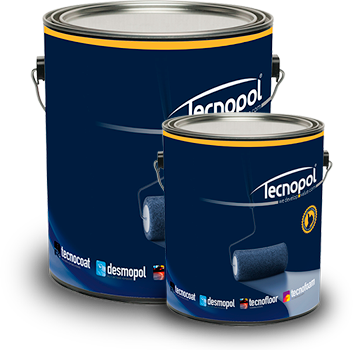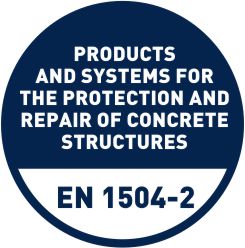GENERAL SPECIFICATIONS
- Two component liquid, hand-applied pure polyurea to form a solid, aromatic, completely adhered to the substrate, seamless, without joints or overlaps, watertight and waterproof membrane to be used on new buildings or refurbishments. It can be applied by short-nap acrylic wool roll, notched trowel.
- It holds an ETA 20/0253, issued by EOTA (European Organization for Technical Assessment). under the EAD 030350-00-0402 guide, specific approval for "Liquid Applied Roof Waterproofing Kit, based on pure polyurea" working life 25 years ( W3), at 1.2 mm thickness, ponding water admitted
- Green roof application certified, root resistance,according to the EN 13948 (ETA 20/0253)
- It has CE marking on the basis of a statement made DoP Declaration of Performance (DoP) conforms to the regulations UE305/2011.
- The application method is by the squeegee, trowel or roll in once coat(self-levelling system).
- Due to its resistance, it can be walked on and it will accept a rough finish to make it non-slip. (using Silica Sand or Tecnoplastic range aggregates)
- A ceramic floor can be placed on top. In this case, we recommend applying a thin coat of Primer PU-1000 or Primer PU-1050, consumption of around 50 to 60 g/sqm, and spreading Silica Sand on top, consumption of around 700-1000 g /sqm, to improve mechanical anchorage.
- Joints and any type of union are saved since the finish is uniform and in one piece, providing a surface with optimal maintenance and cleaning.
- His properties allow it to adhere to any surface such as concrete, ceramic tiles, metals, spray polyurethane foam (Tecnofoam), plywood(OSB), asphalt/bituminous sheets. In any case or material, the surface must be consistent, firm, clean, and dry when the products are applied. Recommended applying directly on the concrete deck.
- It should be applied in dry conditions avoiding the presence of humidity or coming from the surface to be coated or the substrate, whether at the time of application or subsequently (pressure from phreatic water level). In the event there is humidity in the substrate at the time of application.
- It is an aromatic membrane and, even though it is stable against solar radiation it requires solar radiation protection (UV rays) to do not lose its physical and mechanical properties. Therefore, our approved system (under ETA 20/0253), incorporates a protective polyurethane colored aliphatic resin, Tecnotop 2C, for use in the absence of other physical protection elements. You can apply Tecnotop S-3000, Tecnotop 2CP or Tecnotop 1C also.
YIELD
The recommended minimum thickness is up to 1.5 mm., so the yield will be up to 2.3 kg/sqm (DFT) applied on ONE (maximum thickness per coat 0.7 mm./ 1.2 kg/sqm) or various coats , depending on the application method and application conditions.
PACKAGING
Metallic tins in two formats:
- SMALL KIT:4.80 kg and 0.20 kg
- LARGE KIT: 19.2 kg and 0.8 kg
STORAGE AND SHELF LIFE
12-months shelf life is stored in original containers in a dry environment at a temperature between 5-35 ºC (41-95°F). Keep away from direct sunlight, extreme heat, cold or moisture.nce the tin has been opened, the product must be used.
APPLICATION METHOD
Cement or concrete substrates: Concrete should be completely cured (concrete curing takes 28 days) or, in any case, the maximum level of humidity allowed for the substrate should be verified, depending on the primer used. Concrete must be strong, cohesive and dry, having a correct planimetry, high surface resistance, eliminating laitance, graise, oils or release agents, without excessive irregularities. Therefore, the previous action of sanding, polishing, milling or shot-blasting will be assessed by the applicator to achieve a preparation of the substrate according to ICRI Guide 03732, CSP values 3 to 5. Existing holes or areas with a lack of material must be repaired using some of our epoxy resins: Primer EP-1020/Primer EP-1010. Mastic PU must be used on fissures or small cracks on the surface. In joints (width < 15 mm): remove old material, clean and fill with Mastic PU. In joints (width >15 mm): remove old material, clean and fill with Mastic PU. Complement with a Tecnoband 100 band on the upper part. In structural/expansion joints: remove old material, clean and fill with Mastic PU. Complement with specific elastic bands and Tecnoband 100. General cleaning of the substrate. PRIMING: use Primer PU-1050/Primer PUc-1050, Primer EP-1020, Primer EP-1010 or Primer WET, depending on the existing moisture in the substrate.Apply/spray the membrane. Aliphatic polyurethane as an aliphatic topcoat: Tecnotop 1C/2C/2CP.
Ceramic tiles substrate: Ceramic surfaces should not have empty joints or loose elements or parts. These should be filled with Mastic P-2049 mastic or mortar, according to their size. Existing joints or seals: remove the old material, clean up and fill with Mastic P-2049. Sanding with specific equipment. Thereby, to remove moss or solids particles bonded to the substrate, and opening the pore. Clean up, using a vacuum method. PRIMING: use Primer EP-1040, Primer EP-1010 or Primer EPw-1070, depending on the existing moisture in the substrate. Apply/spray the membrane. Aliphatic polyurethane as an aliphatic topcoat: Tecnotop 1C/2C/2CP.
NOTE: For other types of substrates, weather conditions or the substrate to be applied, consult our technical department.
REPAIR AND OVERLAPS PROCESSES
REPAIR: In cases where the membrane repair by accidental causes, or assembly procedures not covered installations, shall be as follows: Cut, removal of the affected area and/or damaged surface. Sanding this area extending about 20~30 cm. around the perimeter, for overlapping security. Cleaning (vacuuming) of waste generated (powder, dust...); if it's possible don't use water, and if used, support humidity value; ketones applicability based solvents for reducing this type of surface cleaning. Apply a thin layer (100-150 g/sqm) of polyurethane resin Primer PU-1030, Primer PU-1050, Prim er PU-1000. Light spread Silica Sand over the wet primer applied before. Wait for the total drying. Apply/spray the membrane evenly and in several layers until the dry film thickness required by the project is achieved. Application of the aliphatic polyurethane resin for protection against UV rays Tecnotop 2C/2CP/1C
OVERLAPS: In cases has been exceeded recoat time (24~48 hours), so the waiting time between jobs is prolonged, proceed as follows: Sanding strip longitudinal overlap of about 20~30 cm. wide. Cleaning (vacuuming) of waste generated (powder, dust...)or existing dust; if it's possible, do not use water, and if it's used, check the support humidity value; ketones applicability based solvents for conducting this type of surface cleaning. Apply a thin layer (100-150 g/sqm) of polyurethane resin Primer PU-1030, Primer PU-1050, Prim er PU-1000. Light spread Silica Sand over the wet primer applied before. Wait for the total drying. Apply/spray the membrane evenly and in several layers until the dry film thickness required by the project is achieved. Application of the aliphatic polyurethane resin for protection against UV rays Tecnotop 2C/2CP/1C
HEALTH AND SAFETY
Respiratory Protection: When handling or spraying use an air-purifying respirator. Skin protection: Use rubber gloves, remove immediately after contamination. Wear clean body-covering. Wash thoroughly with soap and water after work and before eating, drinking, or smoking. Eye / Face: Wear safety goggles to prevent splashing and exposure to particles in the air. Waste: Waste generation should be avoided or minimized. Incinerate under controlled conditions in accordance with local laws and national regulations. Re-occupancy of the work site without respiratory equipment is minimum 24 hours providing the correct ventilation for the area sprayed. Contractors and applicators must comply with all applicable and appropriate guidelines for storage and safety guidelines.These safety recommendations for handling, are necessary for the implementation process as well as in the pre and post, on exposure to the loading machinery. Dispose waste in accordance with star or/and local regulations.
TECHNICAL AND CHEMICAL PROPERTIES
|
PROPERTIES
|
RESULT |
|
Density ISO 1675
|
1.40±0.05 g/cm³
|
| Viscosity ISO 2555 |
3,000 ~ 4,000 cps |
| Density compounds A/B ISO 1675 |
1.45 ±0.05 g/cm³ / 1.05 ±0.05 g/cm³ |
| Viscosity compounds A/B ISO 2555 |
3,000~4,500 cps / 250~500 cps |
| Solids content ISO 1768 |
>85% |
| VOC content (volatile organic compounds) |
250 g/l |
| Tensile strength ISO 527-3 |
6~8 MPa |
| Elongation at break ISO 527-3 |
>500 % |
| Hardness Shore A/D DIN 53.505 |
>85 / >35 |
| Adhesion to concrete/steel/Polyurethane |
1.9MPa / 1.6MPa / 0.2MPa |
| Pot-life/Dry time/Total cured time |
20~25 minutes/±3 hours/±6 days |
| Abrasion resistance (Taber) EN ISO 5470-1 |
1,994 mg (weight loss <3.000mg) |
| Carbon dioxide (CO2) permeability EN 1062-6 |
4.8 g/sqm*day |
| Diffusion-equivalent air layer thickness EN 1062-6 |
S d= 51m |
| Diffusion resistance number EN 1062-6 |
µ= 82,656 |
| Determination of crack bridging properties UNE-EN 1062-7 Static Method |
Class A5 (-10ºC) |
| Determination of crack bridging properties UNE-EN 1062-7 Dynamic Method |
Class B.3.2 (23ºC) |
| Determination of liquid water permeability, EN 1062-3 |
< 0.0004 kg/sqm*h0.5 |
| Bond strength by pull-off EN 1542 |
2.2 MPa |
| Falling-weight test EN ISO 6272-1 |
24.5 Nm (Class III) |
| Diffusion-equivalent air layer thickness EN ISO 7783 |
Sd<5m (Class I) |
| Water-vapor resistance factor EN ISO 7783 |
µ= 1,914 |
| Water-vapor transmission rate EN ISO 7783 |
V= 19,0 g/sqm*day |
| Application temperature range (substrate and environment) |
3~35 ºC (37 to 95ºF ) |
|
Maximum environment humidity
|
±85 %
|
Results were performed in the laboratory at 23ºC(73ºF)and 50% RH, under controllable conditions. These values may vary depending on the application, climatology, or substrate conditions.
TECHNICAL AND CHEMICAL PROPERTIES (ACCORDING TO ETA 20/0253, SYSTEM PROPERTIES)
|
PROPERTIES
|
RESULT |
|
Working-life
|
W3 25 years at 1.2 mm thickness |
| Anti roots certification EN 13948 |
PASS |
| External fire performance EN 13501 |
Broof classification (t1)+ (t4) |
| Fire reaction EN 13501 |
Euroclass E |
| Climatic zone |
S (hard weather) |
|
Water vapor resistance EN 1931
|
µ=2,455
|
| Water-vapor permeability EN 1931 |
14 g/sqm/day |
| Adherence to concrete /steel/polyurethane/ceramic tile |
1,6MPa to 2,1 MPa / 2,4MPa / 0,2MPa /1,6MPa |
| Roof slope |
S1~S4, zero slope, ponding water admitted |
| Temperatures / User loads |
P4:TH2// P3:TH4, concrete / P1:TH2, PU (Spray polyurethane foam)
|
Results were performed in the laboratory at 23ºC(73ºF)and 50% RH, under controllable conditions. These values may vary depending on the application, climatology, or substrate conditions.
ASTM
|
PROPERTIES
|
RESULT |
| Extensibility after heat aging ASTM C1522/C836 |
no cracking, PASS |
| Adhesion-in-peel (after immersion ) ASTM C794/C836 |
2.7 lbf |
| Film thickness at 60 mils ASTM C836 |
61 (60±5, PASS) |
| Crack bridging low temperature ASTM C1305 |
PASS |
| Weight loss ASTM C1250 |
14.9% (<20, PASS) |
| Hardness Shore A ASTM D2240/ASTM C836 |
82 |
| Method for pull-off strength on concrete ASTM D4541 |
546 psi (3.76 MPa) |
|
Hydroestatic pressure resistance (max./feet of water/inches ASTM D5385
|
100 psi (0.689MPa)/231 feet/0,070 in.
|
|
Fire tests ASTM E108-17
|
Class. A
|
Results were performed in the laboratory at 23ºC(73ºF)and 50% RH, under controllable conditions. These values may vary depending on the application, climatology, or substrate conditions.











